 |
Home | Charity | Feedback |
India: Delhi: Delhi
Delhi, India: The majestic side by Prakash Bang, Editor in Chief 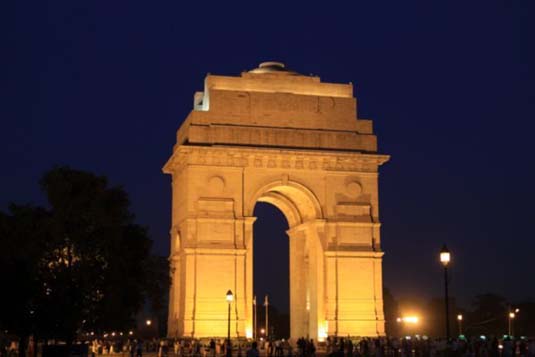 Rule 1: Do not do Delhi in a day. Rule 2: If you have to, make sure to hire a cab. That's what I did when I landed at Delhi airport. Booking the cab for a day makes lot of sense. My sight seeing tour was something like this - Airport - Qutub Minar - Lotus Temple - Humayun's Tomb - Jama Masjid - Red Fort - Mogul Gardens - India Gate - Connought Place - Overnight & out. Even if I had the energy to see more, the Delhi traffic didn't allow me to. Since I avoided using the public transport, I will not be able to share with you the trauma. While the metro rail is one good thing to happen to Delhi, what happens on the ground is quite a different story. Public buses could be easily divided in two. Bad and very bad. Few new ones did look good, but the crowd within was a scary sight. Auto rickshaws and cycle rickshaws were aplenty. There was no such thing as fare meter. Negotiation was the rule of the road. Later in the evening I saw a foreigner couple bargaining with the auto rickshaw driver for the fare. Out of curiosity I learnt that they had arrived that morning itself. Quick learners. I think even if I had the time on hand I still would have opted for a private cab. Depending on the car you choose, the rate per kilometer will wary. 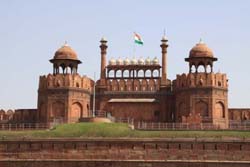 A 20 minute drive from the airport and I was at Qutab Minar. The tower was built in 1193 by Qutabuddin Aibak immediately after the defeat of Delhi's last Hindu kingdom. 73 meters in height, the tower has five distinct storeys, each marked by a projecting balcony and tapers from a base of 15 meters in diameter to just 2.5 meters at the top. Once, visitors were allowed to climb all the way up. It's banned now. The first three storeys are made of red sandstone; the fourth and the fifth storey are of marble and sandstone. At the foot of the tower is the Quwwat-ul-Islam Mosque, the first mosque to be built in India. The construction of the mosque commenced in 1193 and was completed 4 years later.
A 20 minute drive from the airport and I was at Qutab Minar. The tower was built in 1193 by Qutabuddin Aibak immediately after the defeat of Delhi's last Hindu kingdom. 73 meters in height, the tower has five distinct storeys, each marked by a projecting balcony and tapers from a base of 15 meters in diameter to just 2.5 meters at the top. Once, visitors were allowed to climb all the way up. It's banned now. The first three storeys are made of red sandstone; the fourth and the fifth storey are of marble and sandstone. At the foot of the tower is the Quwwat-ul-Islam Mosque, the first mosque to be built in India. The construction of the mosque commenced in 1193 and was completed 4 years later.
Iltutmush in 1230 and Allauddin Khilji in 1315 made additions to the mosque building. The main mosque comprises of an inner and outer courtyard, of which an exquisite colonnade. Most of these shafts are from the 27 Hindu temples, which were razed to construct the mosque. Therefore it's not surprising to see a Muslim mosque with typical Hindu ornamentation. In its courtyard stands a 7 meter high iron pillar. It is believed that if you can encircle it with your hands while standing with your back to it your wish will be fulfilled. Sadly, I could not try my luck as that was locked too. Security measures these days are getting a bit too much! Entry to the Qutab Minar complex is Rs 10 and Rs 250 for Indians and foreigners respectively. 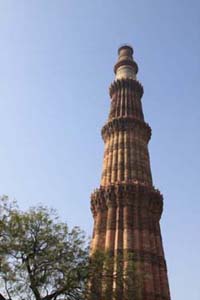 Another 30 minutes drive brought me to The Bahai House of Worship, popularly known as Lotus Temple. This temple is built in the shape of a lotus flower and is the last of seven major Bahai temples built around the world. Completed in1986 it is set amidst 27 acres of beautifully landscaped gardens. Made from concrete and clad with white Greek marble, the structure is 35 meters tall with a diameter of 70 meters. The auditorium seats 1300 people and welcomes people of all faiths to pray and meditate. The architect Furiburz Sabha chose the lotus as the symbol common to Hinduism, Buddhism, Jainism and Islam. The lotus petals bloom from nine pools of water. The Bahai faith is an independent world religion and believes in the oneness of mankind, be it men or women from any faith. Entry to Lotus Temple is free of cost. It's closed on Mondays though.
Another 30 minutes drive brought me to The Bahai House of Worship, popularly known as Lotus Temple. This temple is built in the shape of a lotus flower and is the last of seven major Bahai temples built around the world. Completed in1986 it is set amidst 27 acres of beautifully landscaped gardens. Made from concrete and clad with white Greek marble, the structure is 35 meters tall with a diameter of 70 meters. The auditorium seats 1300 people and welcomes people of all faiths to pray and meditate. The architect Furiburz Sabha chose the lotus as the symbol common to Hinduism, Buddhism, Jainism and Islam. The lotus petals bloom from nine pools of water. The Bahai faith is an independent world religion and believes in the oneness of mankind, be it men or women from any faith. Entry to Lotus Temple is free of cost. It's closed on Mondays though.
Another 40 minutes on the road and I was at the Humayun's Tomb. A magnificent structure set within a lavish garden and certainly a fine example of Mughal architecture in India. It was buit in 1565 AD, nine years after the death of Humayun, by his senior widow Bega Begam. The walled enclosure is home to several graves of Mughal rulers, garden squares with pathways and water channels. In the Mughal dynasty, Humayun is known as 'son of a great father (Babar) and father of a great son (Akbar)'. Further 20 minutes takes you to old Delhi. The best way to move around in this densely populated location is by foot or by cycle rickshaw. We parked the cab in the parking lot about a kilometer away and hired a cycle rickshaw that found its way through chaotic traffic taking us to Jama Masjid and later to the Red Fort. Rule of the thumb to tourist is to shamelessly negotiate the fare beginning at 50% of the quoted rates by the rickshaw drivers. I closed my deal at Rs 60. Locals thought I had paid more. 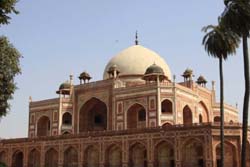 Jama Masjid (mosque) is the largest in India, with a courtyard capable of holding 25,000 devotees. The construction commenced in 1644 and ended up being the final architectural extravagance of Shah Jahan, the Mughal emperor who also built the Taj Mahal and the Red Fort. The highly decorative mosque has three great gates, four towers and two 40 meter high minarets constructed of strips of red sandstone and white marble. As fate would have it I was at the mosque gates at 1 PM on a Friday. Being prayer time I was not allowed in. I could have got in at 2 PM, but since time was short, I took pictures from the outside. Tourists are welcome to get in at non-prayer times and the entry is free. Sad, I missed the opportunity.
Jama Masjid (mosque) is the largest in India, with a courtyard capable of holding 25,000 devotees. The construction commenced in 1644 and ended up being the final architectural extravagance of Shah Jahan, the Mughal emperor who also built the Taj Mahal and the Red Fort. The highly decorative mosque has three great gates, four towers and two 40 meter high minarets constructed of strips of red sandstone and white marble. As fate would have it I was at the mosque gates at 1 PM on a Friday. Being prayer time I was not allowed in. I could have got in at 2 PM, but since time was short, I took pictures from the outside. Tourists are welcome to get in at non-prayer times and the entry is free. Sad, I missed the opportunity.
The Red Fort is opposite to Jama Masjid. The entry to the Red Fort (Lal Quila) is near Lahore Gate. The red sandstone walls rise 33 meters above the clamour of Old Delhi as a reminder of the magnificent power and pomp of the Mughal emperors. The walls, built in 1638, were designed to keep out invaders, now they mainly keep out the noise and confusion of the city. The main gate, Lahore Gate, is one of the emotional and symbolic focal points of modern India and attracts huge crowds each Independence Day from where the Prime Minister of India delivers his speech every 15th August. 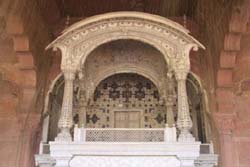 Within the Fort is an arcade, known as Chatta Chowk, a bazaar selling tourist trinkets. The arcade leads into the huge fort compound. Inside is a veritable treasure trove of buildings, including the Naggar Khana (Drum House), the Diwane Aam (Hall of Public Audiences), the Diwane Khaas (white marble Hall of Private Audiences), the Moti Masjid (Pearl Mosque), Hamams (Royal Baths) and Rang Mahal (Palace of Colours). An evening sound and light show re-creates events in India's history connected with the fort. Even today, the fort remains an impressive testimony to Mughal grandeur, despite being attacked by the Persian emperor Nadir Shah in 1739 and by the British soldiers during the war of independence in 1857. The entry fee to the Red Fort is Rs 15 and Rs 250 for Indians and foreigners respectively.
Within the Fort is an arcade, known as Chatta Chowk, a bazaar selling tourist trinkets. The arcade leads into the huge fort compound. Inside is a veritable treasure trove of buildings, including the Naggar Khana (Drum House), the Diwane Aam (Hall of Public Audiences), the Diwane Khaas (white marble Hall of Private Audiences), the Moti Masjid (Pearl Mosque), Hamams (Royal Baths) and Rang Mahal (Palace of Colours). An evening sound and light show re-creates events in India's history connected with the fort. Even today, the fort remains an impressive testimony to Mughal grandeur, despite being attacked by the Persian emperor Nadir Shah in 1739 and by the British soldiers during the war of independence in 1857. The entry fee to the Red Fort is Rs 15 and Rs 250 for Indians and foreigners respectively.
Back to the parking lot, I took the taxi to Hotel Huns Plaza near Connought Place. Enroute I requested the driver to drive me through President's Palace, North & South Blocks and the Parliament Building. Due to security reasons we are not allowed to hang around these highly sensitive locations. Some pictures from the cab's window was just about it. By the way, I missed to view the Moghul Gardens which remain open for public viewing only in the months of February & March. I am told this garden has fantastic collections of roses, various bonsais and orange blooms. 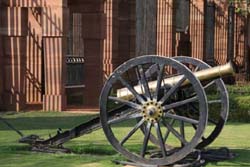 Huns Plaza is a decent business hotel with the top few floors making up for the hotel and the 14 floors below housed offices. My room was on the 17th floor from where I could see the Lotus Temple, as a small speck though. I bid farewell to my taxi driver. The day trip lasted for about 9 hours and clocked 130 kilometers. After having freshened up I headed to India Gate on Rajpath road, 15 minutes away by auto rickshaw.
Huns Plaza is a decent business hotel with the top few floors making up for the hotel and the 14 floors below housed offices. My room was on the 17th floor from where I could see the Lotus Temple, as a small speck though. I bid farewell to my taxi driver. The day trip lasted for about 9 hours and clocked 130 kilometers. After having freshened up I headed to India Gate on Rajpath road, 15 minutes away by auto rickshaw.
India Gate is a structure that reminded me of Arc-de-Triomphe, Paris. The archway stands 42 meters tall and commemorates the 70,000 Indian soldiers who made the supreme sacrifice fighting for the British Army during the World War I. The memorial bears the names of 13,516 British and Indian soldiers killed in the Northwestern Frontier in the Afghan war of 1919. 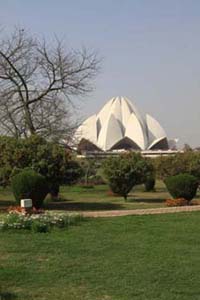 The foundation stone of India Gate was laid by His Royal Highness, the Duke of Connaught in 1921 and it was designed by Edwin Lutyens. The monument was dedicated to the nation 10 years later by the then Viceroy, Lord Irwin. Another memorial, Amar Jawan Jyoti was added much later, after India got its independence in 1947. The eternal flame burns day and night under the arch to remind the nation of soldiers who laid down their lives in the Indo-Pakistan War of December 1971.
The foundation stone of India Gate was laid by His Royal Highness, the Duke of Connaught in 1921 and it was designed by Edwin Lutyens. The monument was dedicated to the nation 10 years later by the then Viceroy, Lord Irwin. Another memorial, Amar Jawan Jyoti was added much later, after India got its independence in 1947. The eternal flame burns day and night under the arch to remind the nation of soldiers who laid down their lives in the Indo-Pakistan War of December 1971.
The entire arch stands on a low base of red Bharatpur stone and rises in stages to a huge moulding. The cornice is inscribed with the Imperial signs while both sides of the arch have INDIA, flanked by the dates MCMXIV (1914) to the left and MCMXIX (1919) to the right. As the evening set in, India Gate was dramatically floodlit. Surrounding the imposing structure is large expanse of lush green lawns, which is a popular picnic spot. I was one amongst hundreds enjoying the view that went undisturbed all the way up to the President's Palace, the North & the South blocks - offices of the Prime Minister, Ministers and bureaucrats of high order. It was 8PM. Time to negotiate the auto rickshaw fare back to the hotel. Delhi Image Gallery  Photo viewer Photo viewer
|
|
|
Home |
Charity |
Feedback
Privacy Policy | Terms of Usage © YoGoYo.com. All rights reserved. |





























